 Aiko Nishikata of the Jerome Office Services Section assembling various documents for a typical file which accompanies each segregee from Jerome to Tule Lake. In this folder are: The family file, educational records, Internal Security report if any, leaves and transfers status, documents from the legal office, occupational coding form, records of the Welfare Division, ration books, and various property receipts. 9/19/43 |
 Evacuees at the Jerome Relocation Center chop their own wood in nearby wooded areas. After it is sawed and split to a convenient size for burning stoves it is piled alongside each barrack. 12/9/43 |
 Hazel Nishimura and George Fujikawa enjoying the last farewell party together. George is leaving for Tule Lake Center. 9/19/43 |
 A view showing the Housing Department at this relocation center. (L to R) Virginia Shilby, secretary. John H. Tucker, Housing. 11/17/42 |
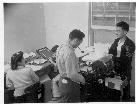 Rolling the presses as the Jerome Communique, project mimeographed newspaper, prepares to hit the streets. (L to R) Eunice Yakota, Stencil Cutter; Kiyomi Nakamura, Mimeograph Operator; Tsugio Makagama, Mimeo Chief; Ray Kawamoto, Communique Artist 11/18/42 |
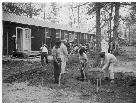 A typical street scene in Block 30. |
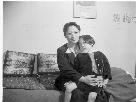 A mother and daughter who are living at this relocation center. The husband and father is in an internment camp. 11/20/42 |
 The chair, table and settee in this barracks home were made by M. Makimoto of 7-06-F. 11/18/42 |
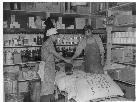 The interior of the storeroom at Mess Hall 7. Chief cook Hamazaki receives supplies from storekeeper Jimmy Saito. |
 A typical interior of a barracks home. |
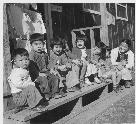 Young children at Jerome Relocation Center. 1/18/44 |
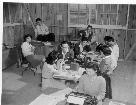 Evacuees on the newspaper staff at work in their office. |
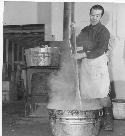 In a corner of a laundry building, Mr. I. Telashita stirs a tub of rendered fats, in preparing soap for center kitchens. The soap factory, set up under the direction of a former California cosmetics manufacturer, Mr. K. Oyama, has produced over 7,000 pounds of soap from waste fats. |
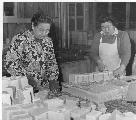 In a makeshift soap factory, at the Jerome Center, Mrs. K. Oyama and Miyo Mishikawa cut bars into hand sizes for use in center kitchens. The soap factory, set up under former California cosmetics manufacturer, Mr. Oyama, utilizes waste meat fats from center kitchens, and has produced 7,000 pounds of soap. 3/11/43 |
 A pre-school class in the Jerome Center grade school. Teachers are Marie Izume, Nelli Nishimura and Emiko Shinagawa. Assistant teachers, such as those shown, are drawn from qualified residents (former west coast persons of Japanese ancestry). 3/10/43 |
 In a third grade class at the Jerome Center grade school resident teacher Miss Saiki answers student study hour questions. Teachers, to assist the appointed teaching personnel, are drawn from qualified center residents (former west coast persons of Japanese ancestry).. 3/10/43 |
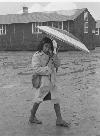 The Arkansas rainy season, and this young resident of the Jerome Center dons rubber boots and carries a parasol. The (buckshot) mud makes the trip to and from school a little difficult. 3/12/43 |
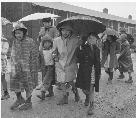 Grade school children leaving the school, at the Jerome Relocation Center. During the rainy season, in the heart of the Arkansas lowlands, the Jerome Center, whose residents are former Californians of Japanese ancestry, was one vast quagmire. 3/12/43 |
 A pattern making class in the adult education division of the Jerome Center schools. Housewives and mothers swelled the rolls of all adult classes that teach subjects which will contribute to the comfort of center living, for themselves and their families. These include pattern making, sewing, arts and crafts, interior decoration, etc. The women shown are learning to design their own clothing, and prepare their own patterns. Instructors are chiefly qualified center residents (former west coast persons of Japanese ancestry). 3/12/43 |
 Closing of the Jerome Center, Denson, Arkansas. Harry Shiramizu, Editor of the Denson Tribune, semi-weekly publication of the Jerome Center, writes finis to that paper's existence after the last copy of the last edition comes off the press. Photographer: 6/16/44 |
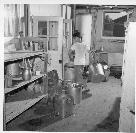 Closing of the Jerome Center, Denson, Arkansas. Dismantling one of Jerome's thirty-three messhalls. The equipment was assembled at warehouse to be sent where needed. 6/21/44 |
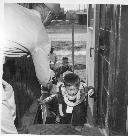 Closing of the Jerome Center, Denson, Arkansas. Travel is just another adventure to the children of the relocation centers. Here a little tot eagerly mounts the steps of the chair car assisted by a member of the military police. 6/15/44 |
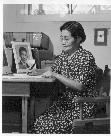 Closing of Jerome Center, Denson, Arkansas. Mrs. M. Nakagama, an evacuee resident of the Jerome Relocation Center, writes to her two sons in the armed forces to notify them of her change of address from one (inclosure) to another. The tow boys, Sergeant Bill T. and Pfc. Sam are stationed at Camp Savage, Minnesota. Mr. and Mrs. Nakagama and a daughter, Fumi, are being moved to the Rohwer Center with the closing of Jerome. The family formerly lived in Denalo, California.. 6/20/44 |
 Closing of Jerome Center, Denson, Arkansas. Here we go again! A typical truck load of Japanese American residents of the Jerome Relocation Center await at the camp's entrance to be loaded on a train and moved to the Gila River Center in Arizona. With the closing of Jerome, the evacuees are being sent in groups of 500 to one or another of the remaining centers. This is the third move for these people since they were compelled to leave their homes on the West Coast. It is the where, when, and how of the next move that occupies their thoughts and is constantly reflected in their faces. 6/18/44 |
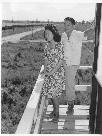 Closing of the Jerome Center, Denson, Arkansas. Clara Hasegawa and Tad Mijake take a last look at the Jerome Center from the balcony of one of the camp's guard towers. The towers have not been manned since segregation was completed during the latter part of 1943 and have been popular with the young folks as a place of rendezvous. This young couple will take up their new residence at the Rohwer Center. 6/19/44 |
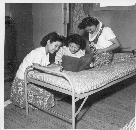 Closing of the Jerome Center, Denson, Arkansas. Three young ladies of the Jerome Relocation Center exchange addresses before leaving to take up their residence in other camps. The closing of the Jerome Center separated many close friends. These girls are camping out after their belongings were shipped. All that remains in the room are the folding cot, mattress and stool [?] supplied by the Government. Left to right, they are: Setsu Kishini, Tsuneko Kayeda (looking at her high school annual) and Mitzi Matsunaga. 6/14/44 |
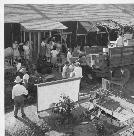 Moving day at the Jerome Center. A typical scene in one of the center's streets as trucks arrive to load up the residents' belongings for shipment to another center. The loading of both freight and the moving of residents was done with such speed and efficiency that scenes like this were of short duration. The screen, prominent in the foreground, serves as a home made partition between beds and affords a degree of privacy, inasmuch as entire families occupy a single room. 6/20/44 |
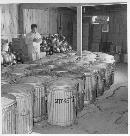 Closing of the Jerome Center, Denson, Arkansas. Dishes from the center's thirty-three mess halls were carefully packed in straw and put in G.I. cans ready for shipment. Angelo Girardo of the Denver Office is shown supervising the work. 6/22/44 |
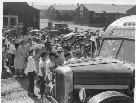 Closing of the Jerome Center, Denson, Arkansas. Jerome residents who are to be moved to the Rohwer Center are assembled at the block mess halls and then taken the thirty mile distance by bus. They are here shown being checked into one of the buses. 6/16/44 |
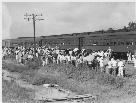 Closing of the Jerome Center, Denson, Arkansas. Scene as one train of 500 Jerome residents leaves for the Gila River Center. 6/18/44 |
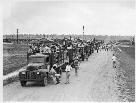 Closing of the Jerome Center, Denson, Arkansas. Jerome residents who are to be sent to the Granada Center wait in trucks to entrain. 6/19/44 |
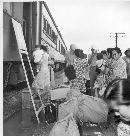 Closing of the Jerome Center, Denson, Arkansas. In the movement of Jerome residents to other centers, infants under 18 months, accompanied by their mothers, and adults of 65 years were provided pullman space, along with persons who were too ill to travel by chair car. Here mothers with small children are being checked and assisted up the steps by M.P.'S and W.R.A. representatives. 6/13/44 |
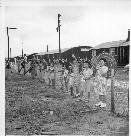 Closing of the Jerome Center, Denson, Arkansas. Evacuees still remaining in the Jerome Center wave to friends on the train from behind the wire fence surrounding the camp. On subsequent departures they were allowed to pass through the gate and say goodbye at close range. |
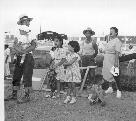 Closing of the Jerome Center, Denson, Arkansas. A typical evacuee family watches the departure of their friends and neighbors who are en route to the Granada Center. 6/19/44 |
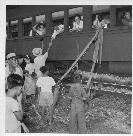 Closing of the Jerome Center, Denson, Arkansas. A sentimental custom still practiced by many when friends part is the trailing of paper streamers from the car windows. The parties hold tightly to the ends of the tape until it is broken by the movement of the train, thus in a sense prolonging the hand clasp. Here two small boys grasp the ribbons which extends to their little friend in the coach window. . 6/19/44 |
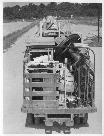 Closing of the Jerome Center, Denson, Arkansas. Evacuees were supplied with cots, blankets, a stove, a broom, and a light bulb when they arrived at the various centers, subsequently most of the furniture had to be home-made from scraps from the lumber pile. The hundreds of trucks were piled high with articles of this type. The conspicuous exceptions were a few cherished possessions, such as the standard dining room table and brass bed probably [illegible] from some resident's former home on the West Coast. |
 Closing of the Jerome Center, Denson, Arkansas. Shigeru Igarashi and Tsuki Kawaguchi, students of the Denson High School, in the Jerome Center, read the closing notice posted on one of the co-op stores from which residents purchase many of the necessities not supplied by the Government. |
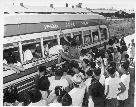 Closing of the Jerome Center, Denson, Arkansas. In the movement of evacuees from Jerome to Rohwer, the trip was made by chartered bus. This is a typical scene at the departure of one of these bus loads. The young lady at the first window is overcome with emotion by this third separation from her friends. 6/16/44 |
 Closing of the Jerome Center, Denson, Arkansas. A little boy and his sister who, with their parents, are to be moved to the Rohwer Center, watch the departure of their playmates on the train to Granada. |
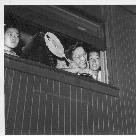 Closing of the Jerome Center, Denson, Arkansas. Many fans were in evidence in the stuffy chair cars as the trains left the humid atmosphere of the Jerome Center for other centers.. 6/19/44 |
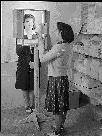
Dorothy Maruki having her identification picture taken with new identification camera in leaves office in order to leave the center. |
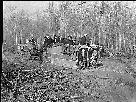
Mud boat capable of seating sixty men, used daily to carry clearing crew in and out of point of operations in the Boeuf River basin, which drains the east section of War Relocation Authority property. Tractor seen in front pulls the mud boat in high gear. This device saves forty minutes on each trip. |

Mud boat capable of seating sixty men, used daily to carry clearing crew in and out of point of operations in the Boeuf River basin, which drains the east section of War Relocation Authority property. Tractor seen in front pulls the mud boat in high gear. This device saves forty minutes on each trip. |
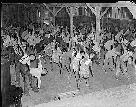
View of second graders doing their rythmic exercises inside grammar school auditorium. |

View of 5th and 6th graders going through their exercises on elementary school grounds. |

A street scene in block 7 on a November afternoon., 11/18/1942 |
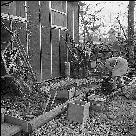
Mrs. T. Arima busily prepares her doorstep garden in Block 7. Besides odd plants and stump arrangements, there will be a pool with goldfish. |
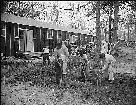
A typical street scene in Block 30., 11/20/1942 |

Children playing house in a makeshift play house., 11/20/1942 |
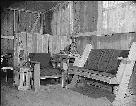
The chairs, table and settee in this barracks home were made by M. Makimoto of 7-06-F. |

The Block 7 kitchen crew pauses for a picture in the early afternoon |
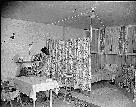
A typical interior of a barracks home., 11/17/1942 |
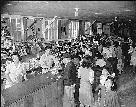
A view of the interior of the store in Block 8, showing the grocery section. |
 Mitzi Matsunaga packs her wardrobe just prior to being moved with her family to the Rohwer Center. Like any well groomed young lady, Mitzi left her summer dresses on the hangers till the last minute to minimize wrinkling. |
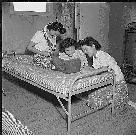
Three young ladies of the Jerome Relocation Center exchange addresses before leaving to take up their residence in other centers. The closing of the Jerome Center separated many close friends. The girls are "camping out" after their belongings were shipped. All that remains in the room are the folding cot, mattresss and stove supplied by the Government. Left to right, they are: Setsu Kishini; Tsuneko Mayeda (looking at her high school annual) and Mitzi Matsunaga. |

Moving day at the Jerome Center. A typical scene in one of the center's streets as trucks arrive to load up the residents belongings for shipment to another center. The loading of both freight and the moving of residents was done with such speed and efficiency that scenes like this were of short duration. The screen, prominent in the foreground serves as a homemade partition between beds and affords a degree of privacy, inasmuch as entire families occupy a single room |
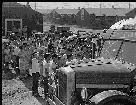
Jerome residents who are to be moved to the Rohwer Center are assembled at the block mess halls and taken the thirty miles distance by bus. They are here shown being checked into one of the buses. |
 Memorial
|
Construction began on July 15, 1942 and the center was ready to be used on October 6. The maximum population was over 8,000, and it was the last of the relocation centers to open and the first to close, closing in June of 1944.
Jerome is the only known instance where evacuees were shot by civilians and not by the military. Three internees were out on a work detail when a tenant farmer on horseback spotted them. He thought they were escapees and opened fire, wounding two.
The government report "Riots, Strikes and Disturbances in Japanese Relocation Centers (1943), points out some problems at the camp.
On February 12, 1943, a person reported to the Army that threats of violence were being made against him. On March 6, 1943, a group of a half dozen evacuees refused to register, saying they were loyal to Japan. At the same time two groups of Japanese attacked two other people, both victims being active in the JACL.
From the Final Report: Japanese Evacuation from the West Coast 1942, published June 5, 1943, a description of the area:"This Project site is adjacent to the town of Jerome, Arkansas, and comprises 10.054 acres, most of which is in Chicot County, Arkansas. The land was obtained from the Farm Security Administration. It is in the Mississippi River Delta and is particularly suited to cotton and vegetables."
Very little of the original structure remains. There is a monument, and a smokestack that is falling apart.

The Oakland Tribune, Sept. 30, 1942
Denson Commique and Denson Tribune from Jerome Assembly Camp
Although there have been many books written about the Japanese-American internment, only some of them even mention the newsletters produced at the camps and, at most, they generally will have only one or two pages from one of the issues.
This is leaving out one of the most historically interesting and important aspects of the internment. The newsletters that were produced give the day-to-day news of interest to the community of those who were interned. I am sure that there were restraints on what the newsletters were allowed to print, but they still tend to contain a wealth of interesting material.
I ran across one particularly valuable source, Densho They have a vast number of the newsletters. I found a few elsewhere.
This particular newsletter had a couple of incarnations. First was the Denson Communique, which ran around forty issues. Then came the Denson Tribune, which ran over 140 issues.
Denson Communique
Issues 1-5
Issues 6 to 10
Issues 11 to 15
Issues 16 to 20
Issues 21 to 25
Issues 26 to 30
Issues 31 to 35
Issues 36 to 41
Denson Tribune
Vol. 1 #1-5
Vol. 1 #6-10
Vol. 1 #11-15
Vol. 1 #16-20
Vol. 1 #21-25
Vol. 1 #26-30
Vol. 1 #31-35
Vol. 1 #36-40
Vol. 1 #41-45
Vol. 1 #46-50
Vol. 1 #51-55
Vol. 1 #56-60
Vol. 1 #61-65
Vol. 1 #66-70
Vol. 1 #71-75
Vol. 1 #76-80
Vol. 1 #81-88
Vol. 2 #1-5
Vol. 2 #6-10
Vol. 2 #11-15
Vol. 2 #16-20
Vol. 2 #21-25
Vol. 2 #26-30
Vol. 2 #31-35
Vol. 2 #36-40
Vol. 2 #41-45
Denson Jiho, May 1944
Main Index
Japan main page
Japanese-American Internment Camps index page
Japan and World War II index page